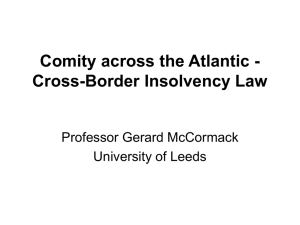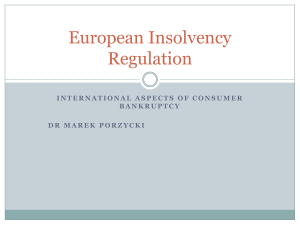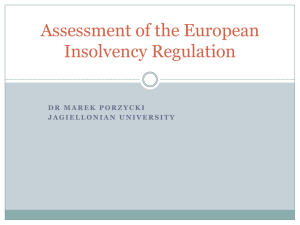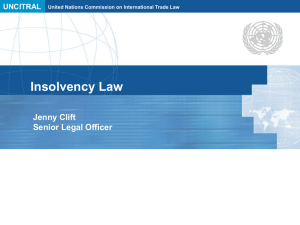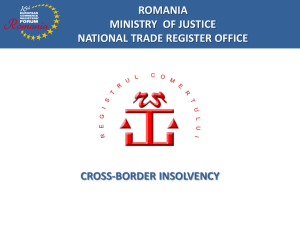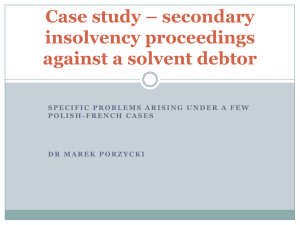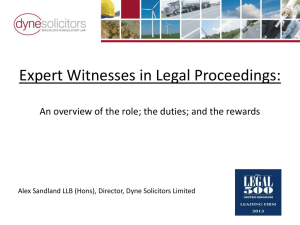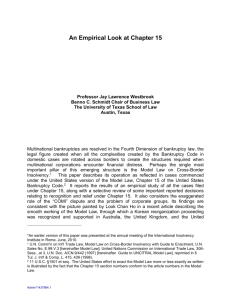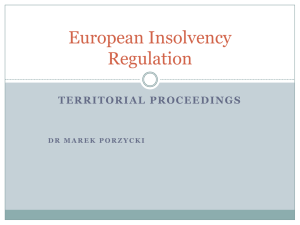International insolvency law
advertisement
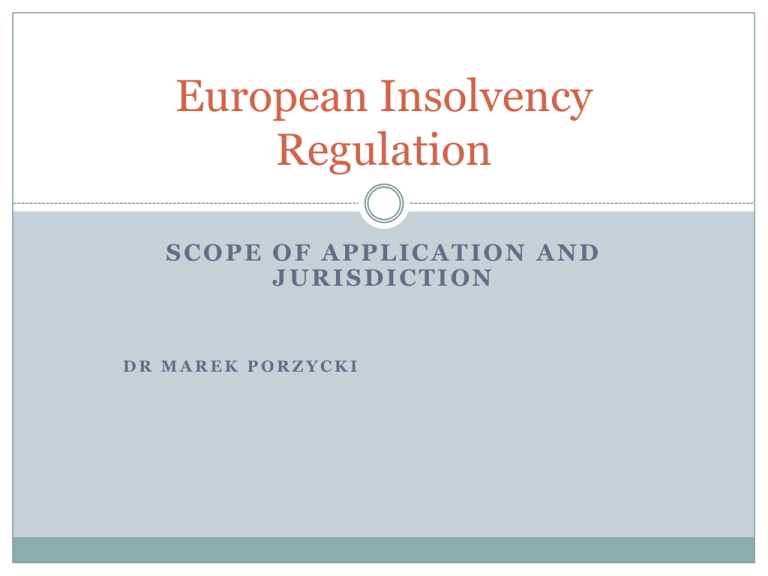
European Insolvency Regulation SCOPE OF APPLICATION AND JURISDICTION DR MAREK PORZYCKI ‘Insolvency proceedings’ Articles 1(1) and 2(a) of the EIR - collective proceedings - based on the debtor’s insolvency - entailing the partial or total divestment of the debtor - appointment of a liquidator ( Annex C) no limitations as to the person of the debtor proceedings against consumers/non-enterpreneurs may also be included list of insolvency proceedings in Annex A to the EIR Exclusion of proceedings against entities listed in Article 1(2) of the EIR Credit institutions – Directive 2001/24/EC of 4 April 2001 on the reorganisation and winding up of credit institutions + national implementing provisions (e.g. Articles 451-470 of the PL Bankruptcy and Rehabilitation Law) Insurance undertakings - Directive 2001/17/EC of 19 March 2001 on the reorganisation and winding-up of insurance undertakings, to be replaced by Articles 267-296 of Directive 2009/138/EC of 25 November 2009 on the taking-up and pursuit of the business of Insurance and Reinsurance (Solvency II) + national implementing provisions (e.g. Articles 481-482 of the PL Bankruptcy and Rehabilitation Law) Investment undertakings and collective investment undertakings – national provisions of cross-border insolvency law (e.g. Articles 378-417 of the PL Bankruptcy and Rehabilitation Law) ‘Insolvency proceedings’ – problematic issues proceedings applicable to solvent, albeit distressed debtors – e.g. French sauvegarde varying degrees of the divestment of the debtor the concept of ‘debtor-in-possession’ temporary liquidators listed in Annex C (cf. ECJ in Eurofood) COMI in the EU centre of main interests (COMI) – defined in recital 13, basis for jurisdiction under Article 3(1)–see below EIR applies only to cases with COMI in the EU – mentioned in recital 14, results also from Article 3 primacy of EU law national law applies in cases outside the scope of the EIR national provisions on cross-border insolvency apply in cases where COMI is situated outside the EU or in Denmark e.g. Articles 378-417 of the Polish Law on Bankruptcy and Rehabilitation Example Bankrupt Inc., a company with COMI in the U.S. has an establishment in Vienna, Austria which coordinates sales across Central Europe. Bankrupt Inc. has an outstanding claim against a debtor in Poland for price of equipment sold by the establishment in Vienna. An Austrian court opens a Konkursverfahren against Bankrupt Inc. The Austrian liquidator wants to sue the Polish debtor before a Polish court and recover the outstanding amount. Can the Austrian liquidator act before a Polish court? Jurisdiction to open insolvency proceedings main insolvency proceedings – COMI of the debtor (Article 3(1) of the EIR) secondary/territorial insolvency proceedings – establishment of the debtor (Article 3(2) of the EIR) – see another presentation Center of main interests (COMI) Recital 13 of the EIR: The "centre of main interests" should correspond to the place where the debtor conducts the administration of his interests on a regular basis and is therefore ascertainable by third parties. objective: predictability for third parties (in particular creditors) legal certainty (see VirgosSchmit, para. 75) „interests” – include not only commercial, industrial or professional activities, but also general economic activities (Virgos-Schmit, para. 75) COMI of legal persons rebuttable presumption of COMI being in the place of the registered office (Article 3 (1) of the EIR) case of ‘letterbox companies’ no particular rules for groups of companies COMI to be assessed separately for each legal person. Control by parent/holding company often taken into account in order to achieve coordination of proceedings within the group in some cases efforts at ‘substantive consolidation’ (but still separate proceedings against each legal person). COMI of legal persons several factors to analyse – e.g. ‘mind of management’, ‘head office’ etc. a comprehensive assessment af all relevant factors needed (see ECJ in Interedil) emphasis on the company’s actual centre of management and supervision and of the management of its interests, ascertainable to third parties (see ECJ in Interedil) an example of a thorough analysis of relevant factors: judgment of the English court for Quayside/Newcastle upon Tyne of 9.2.2005 opening insolvency proceedings against Parkside Flexibles S.A., a company of Polish law COMI of legal persons - examples A German businessman established a limited company in England because of substantially lower costs. The company is registered in London but carries out its activities exclusively in Frankfurt where it is managed. 2. A French holding company has subsidiaries in several other Member States, incorporated as companies under local law. Main decisions concerning the subsidiaries are taken at the premises of the parent company in France, however day-to-day production activities of the subsidiaries take place in the states of their incorporation, where almost all assets and all employees of the subsidiaries are located. 1. COMI of natural persons no legal presumption for traders/enterpreneurs/professionals: professional domicile for non-enterpreneurs/consumers: habitual residence COMI of natural persons – examples 1. 2. 3. Jan Kowalski lives in Słubice, Poland and commutes daily to work as employee in a bicycle repair-shop BikeFix.de in Frankfurt an der Oder, Germany. He is employed on the basis of an employment contract under German law. Jan Kowalski lives in Słubice, Poland and commutes daily to his own bicycle repair-shop BikeFix.de in Frankfurt/Oder, Germany. He is registered as an enterpreneur in Frankfurt/Oder. Jan Kowalski lives in Słubice, Poland and commutes daily to work for BikeFix.de in Frankfurt an der Oder, Germany. In order to avoid the rigidity of German labour law, the owner of BikeFix.de told Jan to register in Frankfurt/Oder as an enterpreneur and concluded a contract for cooperation with him. Jan is paid an hourly rate and works mostly for BikeFix.de, where he spends between 15 and 20 working days per month. ECJ judgments (next presentation) Eurofood, Case C-341/04, 2 May 2006 Staubitz-Schreiber, Case C-1/04, 17 January 2006 Interedil, Case C-396/09, 20 October 2011 note: please read full versions with grounds (indicated on the curia.eu website as „Judgment”) Some issues to be discussed: - when are insolvency proceedings opened? - ‘race to the court’ - shifting COMI during or before the proceedings - possibility of review of a court decision on COMI and international jurisdiction Additional reading - the respective parts of Virgos-Schmit Report - G. Moss, I. Fletcher, S. Isaacs, The EC Regulation on Insolvency Proceedings: A Commentary and Annotated Guide, Oxford University Press 2002, Chapter 3 – Scope and Jurisdiction, pp. 35-44 -P. Torremans, Coming to Terms with the COMI Concept in the European Insolvency Regulation, in: International Insolvency Law, Themes and Perspectives, ed. by Paul Omar, Ashgate 2008, pp. 173-184 -judgment of the combined Court for Quayside and Newcastle upon Tyne of 9.2.2005 opening insolvency proceedings against Parkside Flexibles S.A Additional reading in Polish (selection) F. Zedler, P. Filipiak, A. Hrycaj, Komentarz do rozporządzenia Rady (WE) Europejskie prawo upadłościowe. Komentarz, Wolters Kluwer 2011,commentary to Articles 1-3 of the EIR K. Kohutek: Wszczęcie głównego postępowania upadłościowego przez sąd krajowy posiadający jurysdykcję międzynarodową, Przegląd Prawa Handlowego 2007, nr 11 M. Porzycki, Podstawa jurysdykcji krajowej w głównym postępowaniu upadłościowym, Kwartalnik Prawa Prywatnego 2008, nr 1, p. 219 A. Hrycaj, Jurysdykcja krajowa w sprawach o ogłoszenie upadłości objętych zakresem zastosowania rozporządzenia Rady (WE) Nr 1346/2000 w sprawie postępowania upadłościowego, Wolters Kluwer 2011 [note: the most extensive publication available in Polish]
